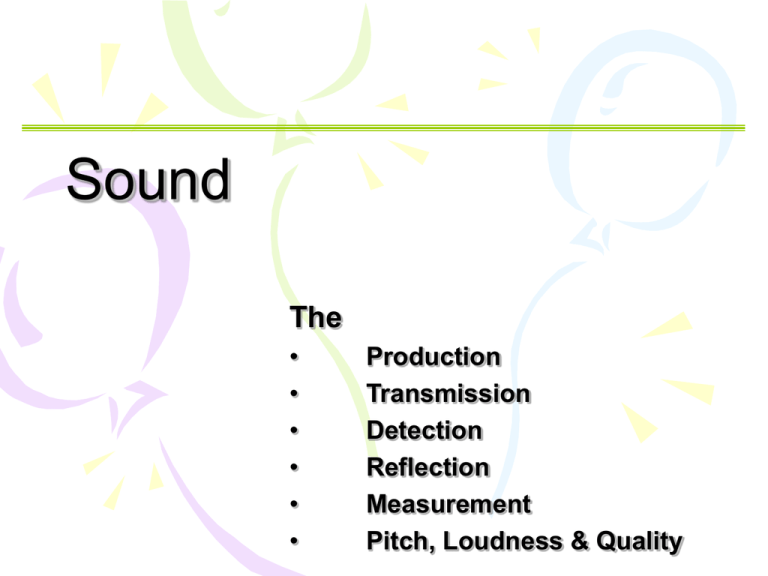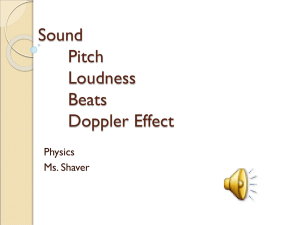
Sound
The
•
•
•
•
•
•
Production
Transmission
Detection
Reflection
Measurement
Pitch, Loudness & Quality
Why do we study this topic on sound?
Sound is experienced in every moment of our
lives. It can come in the form of music, noise or
communication.
Knowledge of sound is also useful in real-life
applications.
E.g. Estimating the depth of the sea
Lesson 1
• Lesson Objectives (Production, Transmission)
– To be able to describe how sound is produce
– To understand the nature of sound
Nature of Sound
• Activity 1
– Ask a friend to hold a piece of paper 10cm in
front of your face.
– Focus your voice on the paper, and try
talking into it.
– Slowly increase the loudness.
(Try putting your hand against your throat and feel too)
What did you notice?
What did you and your friend feel?
Nature of Sound
• Activity 2 (Try this at home)
– Similarly, you may stick a piece of paper in
front of your Hi-Fi woofer.
– Watch what happens to the paper when you
turn up the volume.
(Watch the paper as it comes to music of heavy bass)
Nature of Sound
• Did you notice this?
– The paper seems to be vibrating
• What can you gather?
– Sound is a form of energy
– Originates from a source of vibration or oscillation
Other uses of sound? Hmm…
Nature of Sound
What is sound?
• Sound is a form of energy that is passed from one
point to another as a wave
• Produced by vibrating sources placed in a medium (air,
liquid or solid)
• Longitudinal wave (Eg. Tuning Fork)
Nature of Sound
•
•
For sound waves in air, compressions and rarefactions can be
thought of as changes in air pressure
Other terms used to describe a longitudinal wave includes
amplitude, frequency, period, wavelength, wave Speed.
What do you think…
• We know that light waves (from the sun) are able to
travel through space (vacuum) to reach earth.
– But can sound waves travel through vacuum too?
• Given 3 medium (namely Air, Water and Iron), which do
you think sound travels
– fastest in?
– and slowest in?
• How else can we vary the speed of sound in air?
Transmission of Sound
The Bell-jar Experiment
– We were able to hear the bell ring loud and clear.
– But when the vacuum pump is turned on, the sound becomes
fainter and fainter.
• What does that
mean?
Sound requires a
medium to be
transmitted.
Bell Jar
Alarm clock
or Bell
Vacuum
pump
Transmission of Sound
Transmission of Sound
• Given 3 medium (namely Air, Water and Iron), which do
you think sound travels
– fastest in?
– and slowest in?
In general, molecules in a solid are packed much closer
together than those in a liquid or gas, allowing sound waves
to travel faster through it.
Speed of Sound
Some Interesting Facts:
•
•
Sound waves travel about 5 times faster in fresh water and 17
times faster in iron than in air!
Not all speed of sound in solids are faster than in liquids.
Liquids (25oC)
Gases
Solid
Material
v (m/s)
Material
v (m/s)
Material
v (m/s)
Hydrogen (0oC)
1286
Glycerol
1904
Diamond
12000
Helium (0oC)
972
Sea Water
1533
Pyrex Glass
5640
Air (20oC)
343
Water
1493
Iron
5130
Air (0oC)
331
Mercury
1450
Aluminium
5100
Kerosene
1324
Brass
4700
Methyl Alcohol
1143
Copper
3560
Carbon
Tetrachloride
926
Gold
3240
Lucite
2680
Lead
1322
Rubber
1600
Transmission of Sound
•
How else can we vary
the speed of sound in
air?
–
–
By varying the
temperature.
The table shows how the
speed of sound varies in
different temperature.
The speed of sound is
proportional to T
Temperature
in oC
Speed of Sound
in ms-1
-10
325.4
-5
328.5
0
331.5
5
334.5
10
337.5
15
340.5
20
343.4
25
346.3
30
349.2
Transmission of Sound
• How else can we vary the speed of sound in air?
– By varying the humidity of air.
Humidity is a measure of the amount of water vapor in the air;
the more humid the air is, the faster sound waves travel in it.
– However, pressure does not change the speed of sound in
air.
Questions?
Self Check
• Is sound a form of energy?
• Why do sound travel faster in solids, as compared air?
• Which of these (Temperature, humidity or pressure)
affects the speed of sound in air?
• Do you think sound travels faster or slower in places of
higher altitudes?
Lesson 2
• Lesson Objective (Detection)
– What can we use to determine the frequency of a
sound?
– To identify the spectrum of sound frequencies
• Ultrasound
• Audible range
• Infrasound
– Uses of Ultrasound
(Please read through Handout on How Ultrasound Works)
Do you know…
• Why there are
some whistles
which we cannot
hear?
Eg. Dog whistle
• That commercial
electronic pest
repeller make
use of ‘high
frequency’
sounds to chase
pests away?
• How
gynaecologist
are able to tell
the gender of
a unborn
baby?
Using the Cathode Ray Oscilloscope
• Previously, we briefly talked about how to ‘convert’ a longitudinal
wave into a transverse wave…
• Today, we shall look at one other apparatus that can do that…
the Cathode Ray Oscilloscope (CRO)…
What you will see on the CRO…
• The input sound is first captured (eg. by a Microphone),
and converted into digital signals based on the
loudness of the sound (amplitude), the pitch
(frequency) and the quality.
• In addition, since the waveform is plotted against time,
we will be able to determine the period and frequency
of the sound wave.
Time
Sound Spectrum
• For electromagnetic waves, we have the Electromagnetic
Spectrum.
• For sound, we have the Spectrum of Sound frequencies.
Frequencies (Hz) Also Known As
Remarks
1-20
Infrasound
Not heard by human
ears but can be felt as
vibrations
20-20000
Audible Frequencies The range of
frequencies is also
known as range of
audibility.
20000 & above
Ultrasound
Mainly used in medical
diagnosis.
Medical Diagnosis?
•
•
•
Obstetrics and Gynecology
– measuring the size of the fetus to determine the due date
– determining the position of the fetus to see if it is in the normal head down position or
breech
– checking the position of the placenta to see if it is improperly developing over the opening
to the uterus (cervix)
– seeing the number of fetuses in the uterus
– checking the sex of the baby (if the genital area can be clearly seen)
– checking the fetus's growth rate by making many measurements over time
– detecting ectopic pregnancy, the life-threatening situation in which the baby is implanted
in the mother's Fallopian tubes instead of in the uterus
– determining whether there is an appropriate amount of amniotic fluid cushioning the baby
– monitoring the baby during specialized procedures - ultrasound has been helpful in seeing
and avoiding the baby during amniocentesis (sampling of the amniotic fluid with a needle
for genetic testing). Years ago, doctors use to perform this procedure blindly; however,
with accompanying use of ultrasound, the risks of this procedure have dropped
dramatically.
– seeing tumors of the ovary and breast
Cardiology
– seeing the inside of the heart to identify abnormal structures or functions
– measuring blood flow through the heart and major blood vessels
Urology
– measuring blood flow through the kidney
– seeing kidney stones
– detecting prostate cancer early
Something Extra…
For the past few years, people who are learning the art of
relaxation and the art of yoga is rapidly increasing.
In practising the art of yoga, there is one particular skill
that using the word, or rather the sound ‘ohm’ as the main
key.
But what is so significant about this sound?
Try making the sound on your own, and elaborate how
was the feeling after a while.
Lunch Time Entertainment
Questions?
Self Check
• Is sound wave also a radio wave?
• What can we use to determine the frequency of a
sound wave?
• What range of frequencies can the human ear hear?
• Which range of frequencies do you think the dog
whistle operates in?
• Which area is ultrasound commonly used in?
Lesson 3
• Lesson Objective (Reflection, Measurement)
– Understand how echo is produced
– To measure the speed of sound
• Indirect Method – Using Echo
• Direct Method – Without using Echo
– Other uses of echo
Do you know…
• Why ships are able
to tell the depth of
the ocean water
before deciding to
anchor?
(Sonar)
• What ‘reverb’ stands
for? (We usually see
this word, when we
configure our PC audio
card for games or
applications.)
What is echo?
• What is echo?
– It is the sound heard after the reflection of sound
from a hard, flat surface.
What happens with multiple ‘echoes’?
• Note the ‘rays’ (path) taken by the sound wave…
Multiple Echoes…
Typically in an enclosed hall/gymnasium,
• There will be multiple reflections of sound from the
many reflecting surfaces such as the ceilings and the
walls
• The echoes generated creates an impression that a
sound lasts for a long time
• This effect of prolonged sound due to the merging of
many echoes is called reverberation.
Measuring the Speed of Sound
Direct method:
1.
Students A and B are positioned at a known distance,
s apart.
2.
Student A fires a starting pistol
3.
Student B, upon seeing the flash of the starting
pistol, starts the stopwatch and stops when he hears
the sound. The time interval is then recorded.
Is there any way we can improve this part of the
experiment?
Measuring the Speed of Sound
Direct method Calculation:
•
•
•
As speed (v) is defined as distance travelled per
unit time…
Divide the distance s by the time interval recorded
by the stop watch.
ie. Speed, v = s / t
Repeat the experiment a few times, and take the
average of the calculated speeds.
Note:
The Direct method measure the speed of sound the same
way you measure the speed of a runner, with a stopwatch
on a closed track.
Measuring the Speed of Sound
Indirect method (Using the echo):
1.
2.
3.
4.
Place the 2 wooden blocks at a known distance, s
away from the wall
Make a sharp clapping sound by knocking the 2
blocks of wood together
Repeat the sound at regular intervals to coincide with
the echoes
Start from zero clap and start the stopwatch. Stop the
stop watch at, say, 50 claps
Is there any way we can improve this part of the
experiment?
Measuring the Speed of Sound
Indirect method (Using the echo):
Large wall
Direction of
incident
sound
2 wooden
blocks
•
•
•
Direction of
reflected
sound
(echo)
Distance, s
Find the average time for 1 clap (t)
The speed of sound in air can be calculated by dividing 2s, by
the average time for 1 clap.
Average Speed = 2s / t
Example
Q.
Consider a storm brewing some distance away, and a
lightning strike occurs.
5 seconds later the observer hears the thunder.
Given that the speed of sound in the air is 330m/s.
Can you gauge how far an observer is from a storm
using the speed of sound?
A.
Distance of lightning from observer
= Speed of sound * Time taken
= 330 * 5
= 1650 m
Example
Q.
The annoying sound from a mosquito is produced when it
beats its wings at the average rate of 600 wing beats per
second.
a) What is the frequency (in Hertz) of the sound wave?
b) Assuming the sound wave moves with a velocity of
330 m/s, what is the wavelength of the wave?
A.
a) Frequency = 600Hz
b) Using v = f l,
Wavelength of the wave, l = 330 / 600 = 0.55m
Example
Q.
A man stands some distance away from a cliff. He gives a
shout and hears his echo 4s later. How far away is he
from the cliff?
(Take speed of sound in air to be 330 ms-1)
A.
Time for sound to travel from man to cliff and from cliff to
man is 4s.
Hence, time for sound to travel from man to cliff is 2s.
Therefore, distance between man and cliff is 2330 660m
Challenge yourself…
Q.
The survivor of a shipwreck lands on an island which is
3000 m from a vertical cliff. He sees a ship anchored
between the island and the cliff. A blast from the ship’s
horn is heard twice with a time lapse of 4 s. Calculate the
distance s of the ship from the island.
3000 m
s
Cliff
Other uses of echo
Bats emit a high frequency sound which is
reflected by an object in its path.
Enables the bat to pinpoint the location of
obstacles and avoid them
Questions?
Self Check
• What is an echo?
• How do we measure the speed of sound in air?
• How do you think we can adjust the surrounding to
make echoes more prominent?
• What do you understand by the word ‘feedback’?
Feedback?
Amplifier
Lesson 4
• Lesson Objective
– Understand how the loudness and pitch of
sound is related to amplitude and frequency
of the waveform
– Discuss how the quality of sound is reflected
on the waveform.
Why do a violin and a piano sound different?
Why do a rooster and a monkey sound different?
What distinguishes one sound from another?
The 3 characteristics of sound
• Loudness
• Pitch
• Quality
Loudness
Compare the waveforms below:
What is the difference between them?
The amplitude of vibration.
So how do we vary the amplitude?
Loudness
The loudness of sound is dependent on the
amount of energy which is transferred to the
medium.
It in turn is dependent on the amplitude of
vibrations of the object.
The greater the energy
from the source
(More energy transfer)
Larger amplitude
of vibration
Louder
sound
Common sounds and their estimated loudness
Source
Intensity
Level
Threshold of Hearing (TOH)
0 dB
One convenient
unit of sound level:
Rustling Leaves
10 dB
Decibel (dB)
Whisper
20 dB
Normal Conversation
60 dB
Busy Street Traffic
70 dB
Vacuum Cleaner
80 dB
Large Orchestra
98 dB
Walkman at Maximum Level
100 dB
Front Rows of Rock Concert
110 dB
Threshold of Ear Pain
130 dB
Military Jet Takeoff
140 dB
Instant Perforation of Eardrum
160 dB
The faintest sound
a human ear can
hear is called the
Threshold of
Hearing
Note:
Any sound above 85 dB can cause hearing loss, and the loss is
related both to the power of the sound as well as the length of
exposure.
Pitch
Sound waves are caused when a vibrating
object introduce vibration into a medium.
Vibrating objects e.g. vocal cords,
guitar string, tines of tuning fork,
Medium e.g. air, water particles etc.
How often the particles of the medium
vibrate is referred to the frequency of a
wave.
Pitch
Compare the waveforms below:
Higher
frequency!
What determines the pitch of sound?
The frequency of vibration.
So how do we vary the pitch? E.g. guitar string
Pitch
Each vibrating object has its own frequency.
Human
Piano & Guitar
Higher pitch means? Higher or lower frequency?
Pitch is raised 1 octave with every doubling of
frequency!!
256 Hz 512Hz => pitch is raised by 1 octave
Applet
?
Quality
Similar musical notes (i.e. same pitch) sounds
different on different instruments (e.g. piano and
guitar).
These sounds have different quality or timbre.
Tuning fork
Piano
Trumpet
Quality
Compare the waveforms below:
What determines the quality of sound?
The waveform.
Questions?
Self Check
• What are the 3 characteristics of sound, that will
determine what we hear?
• What happens to the waveform when we try to vary
each of this characteristics?
• A sound mixer is often accompanied with an equalizer.
How will this equalizer affect the output sound?
Summary
What we learnt today …
depends on the amplitude of vibration
Loudness
Loud
Soft
depends on frequency
Characteristics
of sound
Pitch
Low
High
depends on waveform
Quality or
Timbre
Clearer
Mixed
What we have covered…
Production
Vibrating
sources
Transmission
Requires a
medium
Detection
Audibility
Reflection
Echoes
Measuring its
speed
Direct and
indirect method
Pitch, Loudness
and Quality
Different
waveforms
Sound








